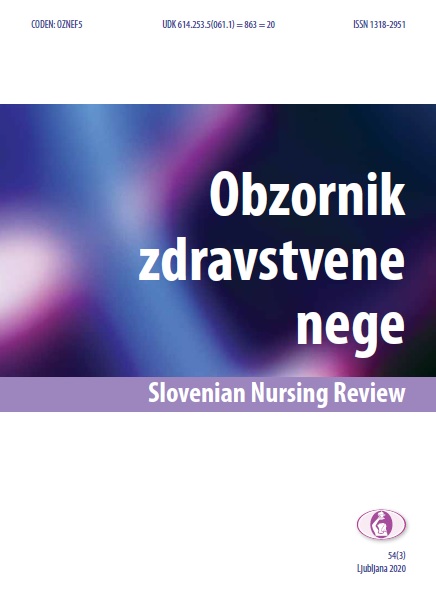Childbearing culture in the Goriška region in the 20th century
a qualitative analysis
DOI:
https://doi.org/10.14528/snr.2020.54.2.2996Keywords:
birth, experience, maternity practice, satisfaction of women, postnatal careAbstract
Introduction: Pregnancy and birth are very important and emotional events for a woman and her family that result in many changes. The purpose of the qualitative research was to examine the birth culture in the Goriška region in the 20th century through birth stories.
Methods: The study used a descriptive interpretative method. We used a dedicated sample of six women who were willing to talk about their birth experience. The youngest of the participants was 66 years old and the oldest was 95 years old. The data were collected through a partially structured interview and analysed using the content analysis method.
Results: Four themes were identified: (1) memories of the woman's birth experience, (2) description of the birth experience in terms of the reality of that time, (3) the supportive role of the narrow and wide community in post-natal care and (4) determining a health status through social status. Midwives and close relatives participated in the birth at home, while the maternity event at the hospital was designed by healthcare professionals. The relief of labour pain was not at the forefront. The birth took place in the back position. Birth information was transmitted from one woman to another. The first birth experience is a turning point in experiencing childbirth.
Discussion and conclusion: Childbirth and postpartum events have mostly met women's expectations at that particular time and space despite the influence of certain social factors and lack of material goods that are now recognized as essential.
Downloads
Metrics
References
Borisov, P., 1995. Ginekologija na Slovenskem od nastanka do 80. let 20. stoletja. Ljubljana: Slovenska akademija znanosti in umetnosti, Razred za medicinske vede, pp. 19–28, 307–311.
Drglin, Z., 2003. Rojstna hiša: kulturna anatomija poroda. Ljubljana: Delta, pp. 40, 167, 193.
Clesse, C., Lighezzolo-Alnot, J., Lavergne, S., Hamlin, S. & Scheffler, M., 2018. The evolution of birth medicalisation: a systematic review. Midwifery, 66, pp. 161–167. https://doi.org/10.1016/j.midw.2018.08.003 PMid:30176390
Henderson, J. & Redshaw, M., 2016. Change over time in women's views and experiences of maternity care in England, 1995–2014: a comparison using survey data. Midwifery, 44, pp. 35– 40. https://doi.org/10.1016/j.midw.2016.11.003 PMid:27889681; PMCid:PMC5156014
Kodeks etike v zdravstveni negi in oskrbi Slovenije in Kodeks etike za babice Slovenije, 2014. Ljubljana: Zbornica zdravstvene in babiške nege Slovenije – Zveza strokovnih društev medicinskih sester, babic in zdravstvenih tehnikov Slovenije.
Kordeš, U. & Smrdu, M., 2015. Osnove kvalitativnega raziskovanja. Koper: Založba Univerze na Primorskem, pp. 40–43. Available at: http://www.hippocampus.si/isbn/978-961-6963-98-5.pdf [5. 4. 2019].
Mičetić-Turk, D., Turk, E. & Šikić Pogačar, M., 2017. Historical overview of breastfeeding in Slovenia. Acta medicobiotechnica, 10(2), pp. 18–24. Available at: http://actamedbio.mf.um.si/03_amb_164-17.pdf [18. 3. 2019].
Nacionalni inštitut za javno zdravje (NIJZ), 2019. Vzgoja za zdravje za bodoče starše. Ljubljana: Nacionalni inštitut za javno zdravje. Available at: https://www.nijz.si/sl/vzgoja-za-zdravjeza-bodoce-starse [25. 8. 2019].
Poličnik, A., 2015. Metode lajšanja porodne bolečine: diplomsko delo. Maribor: Univerza v Mariboru, Fakulteta za zdravstvene vede, pp. 42–44.
Polit, D.F., & Beck, C.T., 2014. Essentials of nursing research: appraising evidence for nursing practice. 9th ed. Philadelphia: Lippincott Williams & Wilkins, p. 191.
Preis, H., Lobel, M. & Benyamini, Y., 2019. Between expectancy and experience: testing a model of childbirth satisfaction. Psychology of Women Quarterly, 43(1), pp. 105–117. https://doi.org/10.1177/0361684318779537
Prosen, M., 2016. Medikalizacija nosečnosti in poroda kot družbena konstrukcija: doktorska disertacija. Maribor: Univerza v Mariboru, Filozofska fakulteta, pp. 256–258, 372.
Prosen, M. & Tavčar Krajnc, M., 2016. Sociological conceptualization of the medicalization of pregnancy and childbirth: the implications in Slovenia. Revija za sociologiju, 43(3), pp. 251–272. https://doi.org/10.5613/rzs.43.3.3
Statistični urad Republike Slovenije (SURS), 2018. Prebivalstvo. Ljubljana: Statistični urad Republike Slovenije. Available at: https://www.stat.si/StatWeb/Field/Index/17 [25. 8. 2019].
Šircelj, M., 2006. Rodnost v Sloveniji od 18. do 21. stoletja (št. 5). Ljubljana: Statistični urad Republike Slovenije, pp. 47– 49.
Vasileiou, K., Barnett, J., Thorpe, S. & Young, T., 2018. Characterising and justifying sample size sufficiency in interview-based studies: systematic analysis of qualitative health research over a 15-year period. BMC Medical Research Methodology, 18(148), pp. 1– 18. https://doi.org/10.1186/s12874-018-0594-7 PMid:30463515: PMCid:PMC6249736
World Medical Association, 2013. World Medical Association Declaration of Helsinki: ethical principles for medical research involving human subjects. Journal of the American Medical Association, 310(20), pp. 2191–2194. https://doi.org/10.1001/jama.2013.281053 PMid:24141714
Yin, K.R., 2010. Qualitative research from start to finish. New York: The Guilford press, p. 177.
Zupančič Slavec, Z., 2018. Zgodovina zdravstva in medicine na Slovenskem. Kirurške stroke, ginekologija in porodništvo. Ljubljana: Slovenska matica: Znanstveno društvo za zgodovino zdravstvene kulture Slovenije, pp. 301–303.
Zupančič Slavec, Z. & Slavec K., 2011. Rojevanje skozi čas. In: Z. Zupančič Slavec, A. Lukanović, J. Simončič & T. Pavček, eds. Rojstvo. Čudež življenja v medicini, fotografiji in poeziji. Ljubljana: Ginekološka klinika UKC Ljubljana v sodelovanju z Društvom Mohorjeva družba, pp. 14–20.
Downloads
Published
How to Cite
Issue
Section
License
As the author undersigned hereby, I transfer, assign, or otherwise convey the following authorship rights as comprised in the Copyright and Related Rights Act (CRRA) to the Slovenian Nursing Review, Ob železnici 30A, 1000 Ljubljana: the right of reproduction - the exclusive right to fix the work in a material medium or in another copy directly or indirectly, temporarily or permanently, by any means and in any digital form, in whole or in part (CRRA, Article 23); the right of distribution (CRRA, Article 24); the right of making a work available and accessible through the internet (CRRA, Article 32a); the right of transformation, especially the exclusive right to translate a pre-existing work (CRRA, Article 33). The transfer of author rights applies to the article in its entirety, including pictorial and/or graphic works and possible supplements. The transfer of rights is exclusive and unlimited in duration or territory.
























